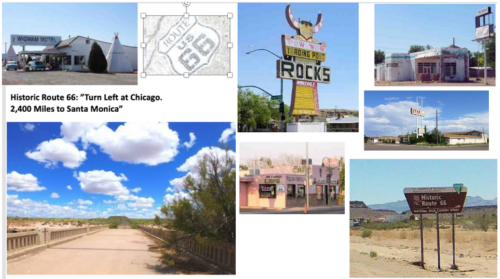Cross Country

It was a common term in the aviation world: “Cross Country.” It meant a lot in that context. Normally, gathering approach plates and navigation materials. Pack something to wear besides a Nomex flight suit and boots. Doing the pre-flight after the briefing, then sling a small military duffle behind the ejection seat, and go fly some place. Recover safely, do a post-flight walk-around, ensure the jet is secure, and then figure out where the nearest and most comfortable rack might be located. And then the Club.
Normally it worked, and it also counted as “training” for some requirement the Ops Officer kept track of. Just part of an interesting working day. But there was a lot behind it all. There were cross countries to arrive someplace on land where the jets hung out. With the same general procedures to organize terrestrial movement.
One of my sons is doing it in furtherance of the business of life. On four wheels in a nice new Cherokee, with a fiancé in the right seat, Potomac-basin-to-Pacific-Ocean. I don’t know how many of those terrestrial cross-countries he has done. He drove back east from his stint working in San Diego after emerging from the Navy life across the water way west. In the trips we shared…well, that is where it gets foggy.
The first one I remember was part of Mom and Dad’s adventure with three kids… in 1961? Rambler Station wagon, Detroit to El Segundo or something, Disneyland and a big blue sea. Superhighways when the idea was still new. Later, multiple drives, Ann Arbor to Park City, Utah, cooler in the back and plenty of drivers to swap on direct through-transits. Second to last started with a morning jab in the ribs in Coronado, California, accompanied by a sleepy admonition to drive to the conference in Washington and at least get one of the two cars across the country for the next assignment back East.
It used to be as normal as a hop from Naval Air Station Miramar to Oceana, two stops to ensure fuel was sufficient, and hope ATC didn’t tell you to add a trap on a carrier conveniently at sea in the local operating area… So, flesh of our flesh is doing it now. As he climbed into cockpit of his SUV, I asked him if he was going to take a break and get off the Interstate and take a peak at what is left of Route 66, the old road west. The one filled with roadside attractions from another age. I remembered one, eastbound, I think, stopping at a place in Arizona that Hollywood used as a standard western set, and the saloon that remained was still authentic and selling a decent drink.
Trying to recall the route, I remembered a stretch of two-lane blacktop in Arizona that is one of the last and best-preserved segments of the original Route 66. There was magic in those miles of one of America’s first transcontinental highways. That portion of the highway once included one of the most fearsome obstacles for “flatland” travelers in the 1930’s: hairpin curves and steep grades through Sitgreaves Pass as it makes its way over the Black Mountains of western Arizona.
The 42 mile Historic Route 66 National Back Country Byway lets you dump the modern imposition of engineered four lanes and go back in memory from McConnico through Oatman and on to Golden Shores. You can jump off I-40 near the McConnico I-40 (exit 44) southwest of Kingman and travel an hour or so on another generation’s way west. That route ends at Golden Shores a few miles north of Topock. The sign is near mile post 47, shortly after turning onto the Oatman Highway. There is another marker at about milepost 34, before you get to Cool Springs. What will they see in these changing times? The Government says we will all be driving electric cars soon to save the planet. I have no idea if there are charging stations planned for the old historic road. Naturally, I would prefer the old gas stations for a fill up before heading for the pass. But this is their cross-country, and I hope the memories the memories they make stay as fresh for them as they were for us. If Route 66 is any indication, it will certainly be different.
Copyright 2021 Vic Socotra
www.vicsocotra.com
